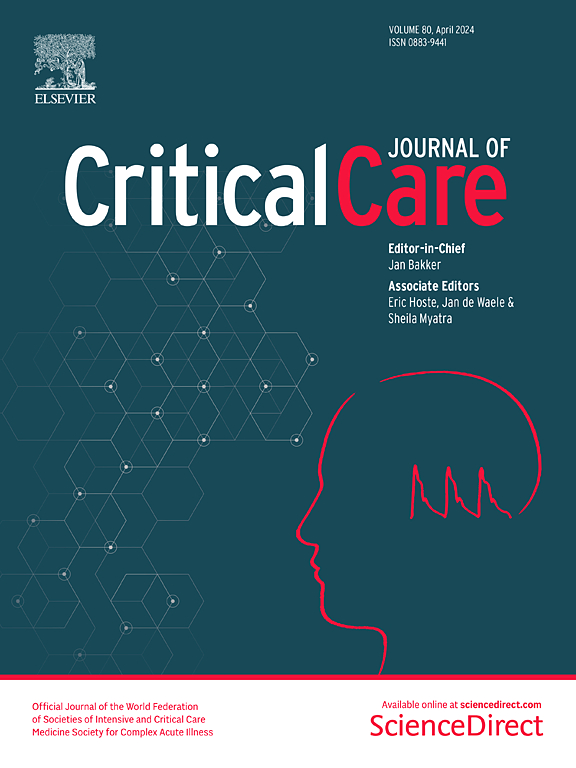Biochemical analysis of soft tissue infectious fluids and its diagnostic value in necrotizing soft tissue infections: a 5-year cohort study
IF 8.8
1区 医学
Q1 CRITICAL CARE MEDICINE
引用次数: 0
Abstract
Necrotizing soft tissue infections (NSTI) are rapidly progressing and life-threatening conditions that require prompt diagnosis. However, differentiating NSTI from other non-necrotizing skin and soft tissue infections (SSTIs) remains challenging. We aimed to evaluate the diagnostic value of the biochemical analysis of soft tissue infectious fluid in distinguishing NSTIs from non-necrotizing SSTIs. This cohort study prospectively enrolled adult patients between May 2023 and April 2024, and retrospectively included patients from April 2019 to April 2023. Patients with a clinical suspicion of NSTI in the limbs who underwent successful ultrasound-guided aspiration to obtain soft tissue infectious fluid for biochemical analysis were evaluated and classified into the NSTI and non-necrotizing SSTI groups based on their final discharge diagnosis. Common extravascular body fluid (EBF) criteria were applied. Of the 72 patients who met the inclusion criteria, 10 patients with abscesses identified via ultrasound-guided aspiration were excluded. Based on discharge diagnoses, 39 and 23 patients were classified into the NSTI and non-necrotizing SSTI groups, respectively. Biochemical analysis revealed significantly higher albumin, lactate, lactate dehydrogenase (LDH), and total protein levels in the NSTI group than in the non-necrotizing SSTI group, and the NSTI group had significantly lower glucose levels and pH in soft tissue fluids. In the biochemical analysis, LDH demonstrated outstanding discrimination (area under the curve (AUC) = 0.955; p < 0.001) among the biochemical markers. Albumin (AUC = 0.884; p < 0.001), lactate (AUC = 0.891; p < 0.001), and total protein (AUC = 0.883; p < 0.001) levels also showed excellent discrimination. Glucose level (AUC = 0.774; p < 0.001) and pH (AUC = 0.780; p < 0.001) showed acceptable discrimination. When the EBF criteria were evaluated, the total scores of Light’s criteria (AUC = 0.925; p < 0.001), fluid-to-serum LDH ratio (AUC = 0.929; p < 0.001), and fluid-to-serum total protein ratio (AUC = 0.927; p < 0.001) demonstrated outstanding discrimination. Biochemical analysis and EBF criteria demonstrated diagnostic performances ranging from acceptable to outstanding for NSTI when analyzing soft tissue infectious fluid. These findings provide valuable diagnostic insights into the recognition of NSTI. Further research is required to validate these findings.软组织感染液的生化分析及其在坏死性软组织感染中的诊断价值:一项为期 5 年的队列研究
坏死性软组织感染(NSTI)病情发展迅速,危及生命,需要及时诊断。然而,将坏死性软组织感染(NSTI)与其他非坏死性皮肤和软组织感染(SSTI)区分开来仍具有挑战性。我们的目的是评估软组织感染液生化分析在区分 NSTI 和非坏死性 SSTI 方面的诊断价值。这项队列研究前瞻性地纳入了2023年5月至2024年4月期间的成年患者,并回顾性地纳入了2019年4月至2023年4月期间的患者。对临床怀疑为四肢NSTI的患者进行了评估,并根据其最终出院诊断将其分为NSTI组和非坏死性SSTI组。采用了通用的血管外体液(EBF)标准。在符合纳入标准的 72 名患者中,有 10 名通过超声引导抽吸确定患有脓肿的患者被排除在外。根据出院诊断,39 名和 23 名患者分别被归入非坏死性脓胸和非坏死性脓胸组。生化分析显示,NSTI 组的白蛋白、乳酸、乳酸脱氢酶(LDH)和总蛋白水平明显高于非坏死性 SSTI 组,NSTI 组的葡萄糖水平和软组织液的 pH 值明显低于非坏死性 SSTI 组。在生化分析中,LDH 在生化指标中表现出突出的区分度(曲线下面积 (AUC) = 0.955;p < 0.001)。白蛋白(AUC = 0.884;p < 0.001)、乳酸(AUC = 0.891;p < 0.001)和总蛋白(AUC = 0.883;p < 0.001)水平也表现出很好的区分度。葡萄糖水平(AUC = 0.774;p < 0.001)和 pH 值(AUC = 0.780;p < 0.001)显示出可接受的分辨能力。在评估 EBF 标准时,Light 标准(AUC = 0.925;p < 0.001)、体液与血清 LDH 比值(AUC = 0.929;p < 0.001)和体液与血清总蛋白比值(AUC = 0.927;p < 0.001)的总分显示出出色的鉴别力。在分析软组织感染性液体时,生化分析和 EBF 标准对 NSTI 的诊断表现从可接受到出色不等。这些发现为识别 NSTI 提供了宝贵的诊断见解。还需要进一步的研究来验证这些发现。
本文章由计算机程序翻译,如有差异,请以英文原文为准。
求助全文
约1分钟内获得全文
求助全文
来源期刊

Critical Care
医学-危重病医学
CiteScore
20.60
自引率
3.30%
发文量
348
审稿时长
1.5 months
期刊介绍:
Critical Care is an esteemed international medical journal that undergoes a rigorous peer-review process to maintain its high quality standards. Its primary objective is to enhance the healthcare services offered to critically ill patients. To achieve this, the journal focuses on gathering, exchanging, disseminating, and endorsing evidence-based information that is highly relevant to intensivists. By doing so, Critical Care seeks to provide a thorough and inclusive examination of the intensive care field.
 求助内容:
求助内容: 应助结果提醒方式:
应助结果提醒方式:


